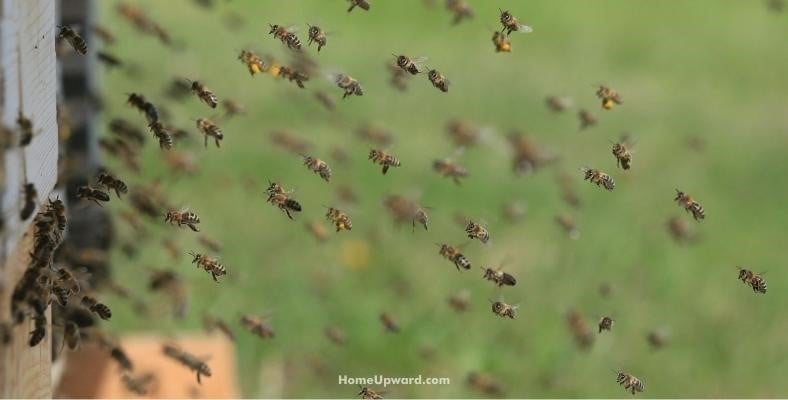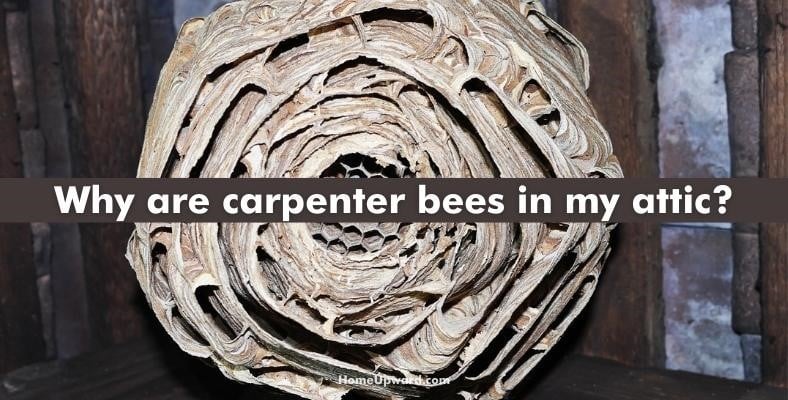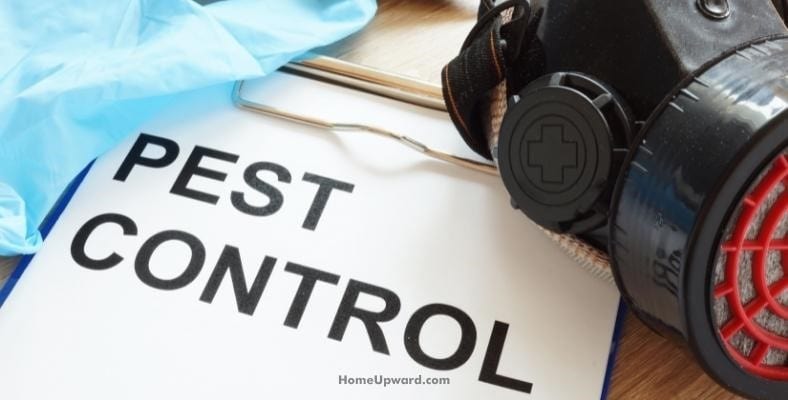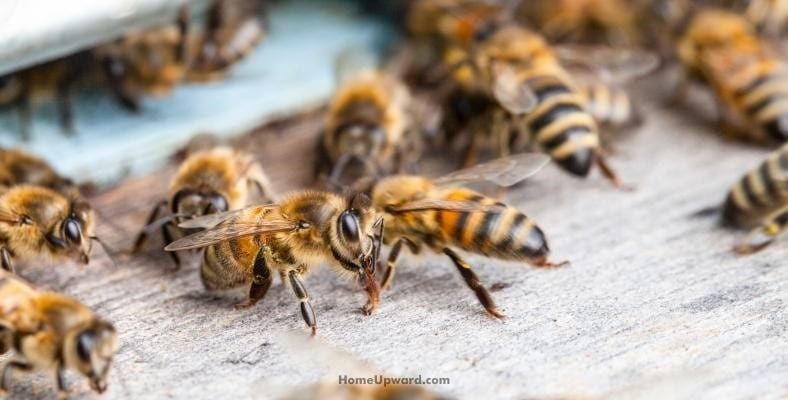Contents
How Do I Know If I Have a Carpenter Bee Infestation?
Carpenter bees gather around your home’s eaves, window and door frames, and decks. If you see these bees around your home, inside or out, you might have a carpenter bee infestation.
The telltale signs of carpenter bees also include:
- Holes in wooden surfaces
- Tiny sawdust piles.
- The sound of buzzing and boring into wood, especially inside your walls.
The holes in your wooden structures can be dangerous if done to weight-bearing structures, like support beams.
Why are carpenter bees a problem?
The female bees bore holes into nearby wood to lay their eggs. They’ll either make new holes or reuse the old ones. But year after year, if allowed to continue to bore holes, they can cause internal damage to the wood which is unseen from the outside due to their many tunnels.
When there are carpenter bees in an attic they’ll move downward if left unattended. The longer they are left without taking action, the more damage they can cause to your wooden structures and the more costly it will be to repair.
What Do Carpenter Bees Look Like?
Unlike honey bees and bumble bees, which have black and yellow stripes, carpenter bees have a black abdomen that is hairless, hard, and very shiny.
Behind their head is a small spot of fuzz that can be yellow, white, brown, black, and even sometimes blue. They are usually about 1 inch long and have long, thin wings.
Male carpenter bees have small white markings on their heads and are larger than female carpenter bees. Females have all-black heads.
Usually females stay in the carpenter bee holes; the males are the ones you’ll usually see buzzing around.
Why Are Carpenter Bees in My Attic?
Carpenter bees burrow deep into wood surfaces, so your attic is the perfect habitat for them. Carpenter bees may occasionally make their homes in treated wood, but they prefer raw, untreated wood, which is likely what your attic is made from.
Do Carpenter Bees Need To Be Removed?
Yes, they need to be removed because if they’re left alone in your home they can eventually cause structural damage. However, you should also consider that they are excellent pollinators essential to the environment’s health.
In the interest of the environment and plant life it’s a great idea to consult a pest control company to see if the bees can be removed without killing them.
How Do You Find a Carpenter Bee Nest?
Carpenter bees don’t live in hives or make hexagonal nests. Instead, they make spherical little holes in soft wood, like pine or cedar. Then they make their nests inside these holes.
You can see these carpenter bee holes in fences, decks, or other wooden structures if there is a carpenter bee presence on your property. These little holes with nests inside will likely have piles of sawdust on the outside and yellow residue which is carpenter bee droppings.
Do Carpenter Bees Sting or Bite You?
Carpenter bees do sting, but only the females. Neither one will normally be aggressive to people or pets without being provoked.
The males may divebomb you to defend their nests because the females are deep inside the nests laying eggs and taking care of the larvae. You’re not likely to see females buzzing around which is good because their bee stings hurt!
Carpenter bee stings are not toxic or poisonous so you’re not in any real danger.
Can You Hear Carpenter Bees Eating Wood?
If you have a carpenter bee issue you will likely hear buzzing in your walls. They don’t eat the wood but chew through it to make their nests.
You can sometimes hear this unsettling wood-chomping sound inside your walls. Female carpenter bees vibrate their large mandibles against softwood surfaces to bore holes into the wood.
It sounds very much like a buzzing grinding sound as if a small power tool with a rotary bit was being used to grind wood.
How Do I Get Rid of Carpenter Bees in My Attic?
To remove carpenter bees in an attic, call a pest control company. As we mentioned earlier, carpenter bees are vital to the environment and if you can remove them from your home without killing them that’s the best-case scenario.
Pest control professionals will know how to do just that. On the flip side, you could spray pesticide yourself directly into their holes, which should kill the females and their eggs.
However, it will also contaminate your home with potentially dangerous chemicals and create a mess for you to clean up later.
Do Carpenter Bees Damage Your Home?
You may not think that a few carpenter bee holes are a big deal, but over time these can multiply extensively and cause structural damage to the wood in which they occur. Safe carpenter bee removal is a must if these busy burrowers have taken up residence anywhere in or near your home.
Carpenter bee populations spread over a large area rather than in a single hive, like honeybees. Over time, as the female carpenter bees create more holes, the structural integrity of that area of your home is compromised.
How Much Does It Cost To Get Rid of Carpenter Bees?
It’s going to be cheaper if you go for a DIY solution. You just need to pay for the pesticide you use and some personal protective gear like goggles and gloves.
However, if you’re allergic to stinging insects, have a large-scale infestation, or would simply like to let a professional company handle the situation, removing carpenter bees can cost anywhere from about $100 to $500 or more.
Most pest control services charge hourly rates because the heavier the infestation the longer it takes to complete the job. Additionally, they can’t determine the intensity of a pest infestation with a simple glance.
Especially when it comes to burrowing insects like carpenter bees the professional on the job may not know how extensive the infestation is until they’re already working on eliminating it.






